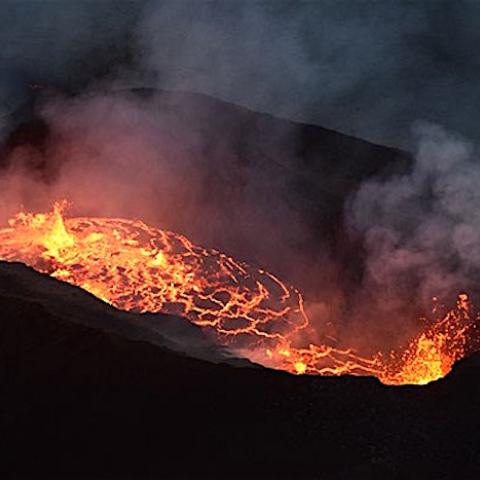
Solace found at sunrise over the steaming cliffs at Wahinekapu/NPS, Janice Wei
Mainlanders hoping to escape winter with a trip to Hawai'i Volcanoes National Park might encounter many others with the same plan, and so park rangers have pulled together some tips for fleeing the crowds.
As with many other parks, the prevailing wisdom at Hawai'i Volcanoes is to hit the park website before you hit the trail, and avoid the crowded summit area between 9 a.m. to 4 p.m.
The website, www.nps.gov/hawaiivolcanoes, is the first stop all visitors and tour operators should make before coming to the park. Recent updates includes the Plan Your Adventure landing page that features tips to avoid crowds, off-the-beaten-path destinations, what not to do, and how to stay safe.
Most visitors stop at Kīlauea Visitor Center for information, to watch the park movie, or to join a ranger-guided hike, but changes are coming to serve visitors during the holiday surge. The visitor center and the park store, run by Hawai‘i Pacific Parks Association, will open an hour earlier, at 8 a.m., and close at 5 p.m., starting December 20 through January 6, 2020. Some ranger programs will relocate to the coast and Chain of Craters Road destinations, like Mauna Ulu. The 20-minute park movie, Born of Fire, Born of the Sea, will only be shown before 10 a.m. and after 2 p.m., with six shows a day from November 23 through January 18. A shorter orientation film will replace it.
“We plan for and experience robust visitation every winter season, but the closure of Jaggar Museum and Kīlauea Overlook due to the destructive 2018 eruption has dramatically reduced the number of parking stalls,” said acting Superintendent Rhonda Loh. “We don’t want to turn anyone away from visiting the park, so we’re relying on visitors to take our advice, arrive earlier, explore less-visited areas, and drive safely,” she said.
Top Ranger Tips for a happy holiday visit to Hawai‘i Volcanoes National Park:
•Turn Left for Adventure and Less Crowded Trails. When you enter the park, get in the left lane, and turn left at the entrance station to drive down the 19-mile Chain of Craters Road towards the park’s dramatic lava-covered coast. Stop at crater pullouts along the way, hike along the Mauna Ulu fissure eruption, connect to Hawaiian culture at Pu‘u Loa Petroglyphs, and enjoy scenic overlooks and the Hōlei Sea Arch.
•Kīlauea Iki Trail. If Kīlauea Iki is on your must-hike list, set your alarm or set your sights on a different trail. This newly reopened four-mile loop trail is the most popular hike in the park and parking at the trailhead is jam-packed after 9 a.m. Park at Devastation Trail parking lot instead. Adding another 2.2 miles to your trek will subtract the stress. Plan to hit the trail by 7 a.m., and be out by 10 a.m.
•Sunrise at the Summit. Watching sunrise over Kīlauea caldera from Steaming Bluff is a mystical experience, and all the proof you need that Kīlauea is still very much an active volcano. It’s also an ideal time to ponder the summit collapse that occurred during the 2018 eruption. The park is open 24 hours, 365 days a year (except for Kahuku).
•Mauna Loa Road is well worth exploring during peak hours, especially in good weather. Kīpukapuaulu offers an easy, forested hike, and the views and birding are excellent along the way to the Mauna Loa Overlook at 6,662 feet.
•Visit Kahuku. Kahuku is free, never crowded, and is open Wednesday through Sunday from 9 a.m. to 4 p.m. Located on the mauka (inland) side of Highway 11 near mile marker 70.5 in Ka‘ū.
•Leave your drone at home. Recreational drones are not allowed in Hawai‘i Volcanoes National Park. They disturb wildlife, interfere with park operations, and bother people trying to enjoy natural sounds.
•Take the Pono Pledge. Vow to stay safe, and to ensure your park’s incredible geologic, natural and cultural resources are here for future generations to behold by taking the Pono Pledge. Pono means “the right thing to do” in Hawaiian. Be pono!




 Support Essential Coverage of Essential Places
Support Essential Coverage of Essential Places







Add comment